Popular categories
Looking for a yarn?

50% Alpaca, 33% Cotton, 17% Wool
from 4.80 £ /50g
Order DROPS Wish from Wool Warehouse Direct Ltd
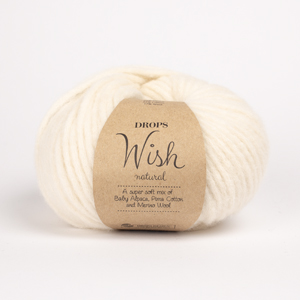
|
DROPS Wish natural 50% Alpaca, 33% Cotton, 17% Wool |
4.80 £ /50g |
Order |

|
DROPS Wish uni colour 50% Alpaca, 33% Cotton, 17% Wool |
4.80 £ /50g |
Order |

|
DROPS Wish mix 50% Alpaca, 33% Cotton, 17% Wool |
4.80 £ /50g |
Order |
Clicking the ORDER button will redirect you to Wool Warehouse Direct Ltd website
Order DROPS Needles & Hooks
Clicking the ORDER button will redirect you to Wool Warehouse Direct Ltd website
The yarn cost is calculated from the pattern’s smallest size and the yarn’s cheapest product type. Looking for an even better price? You might find it on the DROPS Deals!
Winter Hive
Knitted jumper for men in DROPS Wish. The piece is worked with cables, honeycomb pattern and high neck. Sizes S - XXXL.
DROPS Design: Pattern no wi-019
Yarn group E
-------------------------------------------------------
SIZES:
S - M - L - XL - XXL - XXXL
MATERIALS:
DROPS WISH from Garnstudio (belongs to yarn group E)
600-650-700-800-850-950 g colour 04, wheat
NEEDLES:
DROPS CIRCULAR NEEDLE SIZE 8 MM: Length 40 cm and 60-60-60-80-80-80 cm.
DROPS CIRCULAR NEEDLE SIZE 7 MM: Length 40 cm and 60-60-60-80-80-80 cm.
DROPS DOUBLE POINTED NEEDLES SIZE 8 MM.
DROPS DOUBLE POINTED NEEDLES SIZE 7 MM.
DROPS CABLE NEEDLE: for cables.
The technique MAGIC LOOP can be used – you then only need circular needle of 80 cm in each size.
KNITTING TENSION:
11 stitches in width and 15 rows in height with stocking stitch = 10 x 10 cm.
NOTE: Needle size is only a guide. If you get too many stitches on 10 cm, change to a larger needle size. If you get too few stitches on 10 cm, change to a smaller needle size.
-------------------------------------------------------
Alternative Yarn – See how to change yarns here
Yarn Groups A to F – Use the same pattern and change the yarn here
Yarn usage using an alternative yarn – Use our yarn converter here
-------------------------------------------------------
Men Men's Jumpers Chunky Knitsbottom up cable chunky knits high neck honeycomb round neck

50% Alpaca, 33% Cotton, 17% Wool
from 4.80 £ /50g
Order DROPS Wish from Wool Warehouse Direct Ltd

|
DROPS Wish natural 50% Alpaca, 33% Cotton, 17% Wool 4.80 £ /50g Order |

|
DROPS Wish uni colour 50% Alpaca, 33% Cotton, 17% Wool 4.80 £ /50g Order |

|
DROPS Wish mix 50% Alpaca, 33% Cotton, 17% Wool 4.80 £ /50g Order |
Clicking the ORDER button will redirect you to Wool Warehouse Direct Ltd website
Order DROPS Needles & Hooks
Clicking the ORDER button will redirect you to Wool Warehouse Direct Ltd website
The yarn cost is calculated from the pattern’s smallest size and the yarn’s cheapest product type. Looking for an even better price? You might find it on the DROPS Deals!
- English (UK/cm)
- Česky
- Dansk
- Deutsch
- Eesti keel
- English (US/in)
- Español
- Français
- Íslenska
- Italiano
- Magyar
- Nederlands
- Norsk
- Polski
- Português
- Suomi
- Svenska
- English (UK/cm), Bulgaria
- English (UK/cm), Croatia
- English (UK/cm), Greece
- English (UK/cm), Latvia
- English (UK/cm), Lithuania
- English (UK/cm), Romania
- English (UK/cm), Slovenia
- Česky, Slovakia
Pattern instructions
EXPLANATIONS FOR THE PATTERN:
-------------------------------------------------------
RIDGE/GARTER STITCH (worked back and forth):
Knit all rows.
1 ridge = knit 2 rows.
PATTERN:
See diagrams A.1 to A.6. The diagrams show all rows in the pattern from the right side.
DECREASE TIP-1 (evenly spaced):
To work out how to decrease evenly, count the total number of stitches on needle (e.g. 36 stitches) and divide by number of decreases to be made (e.g. 4) = 9.
In this example decrease by knitting together each 8th and 9th stitch.
INCREASE TIP (for sleeves):
Start 1 stitch before the marker thread, 1 yarn over, knit 2 (marker thread sits between these 2 stitches), 1 yarn over. On the next round knit the yarn overs twisted to avoid holes (2 stitches increased).
-------------------------------------------------------
START THE PIECE HERE:
-------------------------------------------------------
JUMPER – SHORT OVERVIEW OF THE PIECE:
The front and back pieces are worked separately, back and forth and bottom up then sewn together. The sleeves are worked in the round with double pointed needles/short circular needle. The neck is worked to finish.
FRONT PIECE:
Cast on 74-82-82-90-98-106 stitches with circular needle size 7 mm and DROPS Wish. Purl 1 row from the wrong side. Then work as follows from the right side: 1 edge stitch in GARTER STITCH – read description above, knit 2, * purl 2, knit 2 *, work from *-* over the next 4-8-8-12-16-20 stitches, A.1 (= 14 stitches), A.2 (= 32 stitches), A.3 (= 14 stitches), knit 2, * purl 2, knit 2 *, work from *-* over the next 4-8-8-12-16-20 stitches, 1 edge stitch in garter stitch. Work this rib for 6 cm.
Change to circular needle size 8 mm. Then work as follows from the right side: 1 edge stitch in garter stitch, stocking stitch over the next 6-10-10-14-18-22 stitches and decrease 1-2-0-1-2-3 stitches over these stitches, A.4 (= 14 stitches), A.5 (= 32 stitches), A.6 (= 14 stitches), stocking stitch over the next 6-10-10-14-18-22 stitches and decrease 1-2-0-1-2-3 stitches over these stitches, 1 edge stitch in garter stitch = 72-78-82-88-94-100 stitches. Continue this pattern. REMEMBER THE KNITTING TENSION!
When the piece measures 47-48-49-50-51-52 cm, cast off 3-4-4-5-7-9 stitches at the beginning of the next 2 rows for the armholes = 66-70-74-78-80-82 stitches. Continue the pattern until the piece measures 60-62-64-66-68-70 cm. Now decrease 14 stitches evenly over A.5. On the next row place the middle 12-12-12-14-14-14 stitches on a thread for the neck and finish each shoulder separately. Then cast off stitches on each row from the neck as follows: 2 stitches 1 time and 1 stitch 2 times = 16-18-20-21-22-23 stitches on the shoulder. Continue working until the piece measures 65-67-69-71-73-75 cm, then decrease 4 stitches evenly over the cable in A.4/A.6 = 12-14-16-17-18-19 stitches. Work until the piece measures 66-68-70-72-74-76 cm, cast off. Work the other shoulder in the same way.
BACK PIECE:
Cast on 74-82-82-90-98-106 stitches with circular needle size 7 mm and DROPS Wish. Purl 1 row from the wrong side. Then work as follows from the right side: 1 edge stitch in garter stitch, knit 2, * purl 2, knit 2 *, work from *-* over the next 4-8-8-12-16-20 stitches, A.1 (= 14 stitches), A.2 (= 32 stitches), A.3 (= 14 stitches), knit 2, * purl 2, knit 2 *, work from *-* over the next 4-8-8-12-16-20 stitches, 1 edge stitch in garter stitch. Work this rib for 6 cm.
Change to circular needle size 8 mm.
Then work as follows from the right side: 1 edge stitch in garter stitch, stocking stitch over the next 6-10-10-14-18-22 stitches and decrease 1-2-0-1-2-3 stitches over these stitches, A.4 (= 14 stitches), A.5 (= 32 stitches), A.6 (= 14 stitches), stocking stitch over the next 6-10-10-14-18-22 stitches and decrease 1-2-0-1-2-3 stitches over these stitches, 1 edge stitch in garter stitch = 72-78-82-88-94-100 stitches. Continue this pattern.
When the piece measures 47-48-49-50-51-52 cm, cast off 3-4-4-5-7-9 stitches at the beginning of the next 2 rows for the armholes = 66-70-74-78-80-82 stitches. Continue the pattern until the piece measures 64-66-68-70-72-74 cm. Now decrease 14 stitches evenly over A.5. On the next row cast off the middle 18-18-18-20-20-20 stitches for the neck and finish each shoulder separately. Then cast off 1 stitch on the next row from the neck = 16-18-20-21-22-23 stitches on the shoulder. Continue working until the piece measures 65-67-69-71-73-75 cm, then decrease 4 stitches evenly over the cable in A.4/A.6 = 12-14-16-17-18-19 stitches. Work until the piece measures 66-68-70-72-74-76 cm, cast off. Work the other shoulder in the same way.
SLEEVE:
Cast on 36-40-40-44-44-48 stitches with double pointed needles size 7 mm and DROPS Wish. Knit 1 round then work rib (knit 2, purl 2) for 6 cm.
Change to double pointed needles size 8 mm and knit 1 round where you decrease 4-6-4-6-4-6 stitches evenly spaced – read DECREASE TIP = 32-34-36-38-40-42 stitches. Insert a marker thread at the beginning of the round = mid-under sleeve. Work stocking stitch in the round. When the sleeve measures 8 cm, increase 1 stitch on each side of the marker thread– read INCREASE TIP. Increase like this every 11-11-10½-10½-10-9½ cm a total of 5 times = 42-44-46-48-50-52 stitches. When the sleeve measures 56-55-54-53-50-49 cm, finish the sleeve cap back and forth (from mid-under sleeve). Continue working until the sleeve measures 58-58-57-57-56-56 cm (sleeve cap 2-3-3-4-6-7 cm). Cast off. Work the other sleeve in the same way.
ASSEMBLY:
Sew the shoulder seams. Sew the sleeve cap to the armhole. Then sew the split at the top of the sleeve along the bottom of the armhole – see sketch. Sew the side seams inside the 1 edge stitch.
NECK:
Start from the right side on one shoulder and knit up 56 to 64 stitches around the neck (including the stitches on the thread), with short circular needle size 7 mm and DROPS Wish. The number of stitches should be divisible by 4. Work rib (knit 2, purl 2) for 12 cm. Cast off with knit over knit and purl over purl.
This pattern has been corrected. Click here to see the correction/s.
BACK PIECE: ...Change to circular needle size 8 mm.
Then work as follows from the right side: 1 edge stitch in garter stitch, stocking stitch over the next 6-10-10-14-18-22 stitches and decrease 1-2-0-1-2-3 stitches over these stitches, A.4 (= 14 stitches), A.5 (= 32 stitches), A.6 (= 14 stitches), stocking stitch ...
Diagram

|
= knit from right side, purl from wrong side |

|
= purl from right side, knit from wrong side |

|
= place 2 stitches on cable needle in front of piece, knit 2, knit 2 from cable needle |

|
= place 2 stitches on cable needle behind the piece, knit 2, knit 2 from cable needle |

|
= place 4 stitches on cable needle in front of piece, knit 4, knit 4 from cable needle |

|
= place 4 stitches on cable needle behind the piece, knit 4, knit 4 from cable needle |

|
= Sew the sleeve to the armhole: Sew a to A and b to B |

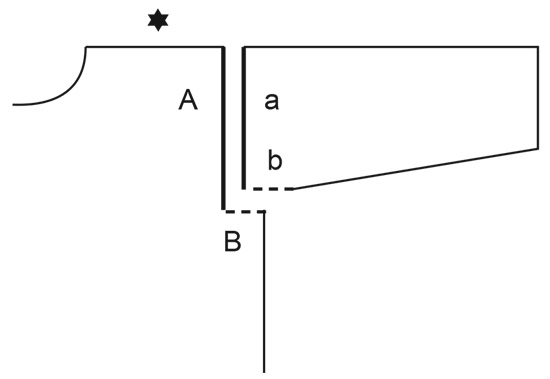
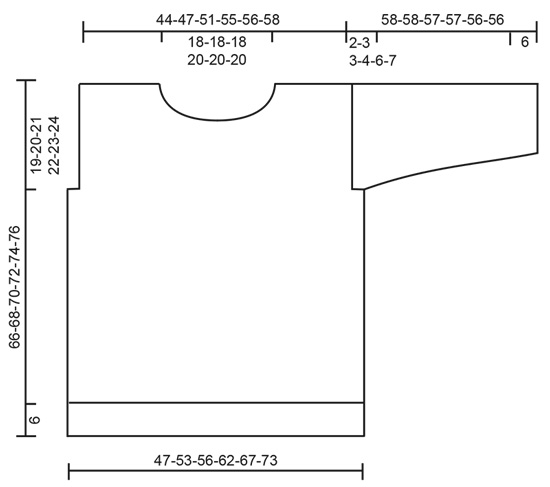
What can you do with our patterns? You can share DROPS patterns online, using the pattern original picture, materials, name and number. But you are NOT ALLOWED to reproduce the complete pattern digitally in any way. Yarn stores are welcome to use the DROPS pattern database to promote the sale of our assortment. You can print out our patterns, make as many copies as you’d like. The only thing we ask is that you don't make any changes / additions to the original printed document. And that the patterns according to the DROPS philosophy are given out to the consumers for free. Editorials that wish to publish our patterns in printed books or magazines can contact us for more information. The sale of garments based on DROPS patterns is permitted as long as they are sold as single items or per order. Further commercial use of the patterns is not permitted. It has to be clearly stated that the garment is made based on a design from DROPS DESIGN. The use of clothing labels of which DROPS DESIGN forms part is conditioned by the inclusion of the following text: “A DROPS DESIGN made by …..”. The use of DROPS photos for marketing purposes/sales is only permitted in connection with the use/sale of DROPS products. The photos may not be cut or edited and the logo should be clearly visible.
We reserve the right to withdraw the permission for use of our patterns at any time, notwithstanding the reason.
Each of our patterns has specific tutorial videos to help you.
These step-by-step tutorials might also help you:
Why is the knitting/crochet tension so important?
Knitting tension is what determines the final measurements of your work, and is usually measured per 10 x 10 cm. It is provided like so: number of stitches in width x number of rows in height - eg: 19 stitches x 26 rows = 10 x 10 cm.
The knitting tension is very individual; some people knit/crochet loosely while others work tightly. You adjust the knitting tension with the needle size, which is why the suggested needle size is only meant as a guide! You need to adjust this (up or down) to ensure that YOUR knitting tension matches the knitting tension provided in the pattern. If you work with a different knitting tension than provided you will have a different yarn consumption, and your work will have different measurements than what the pattern suggests.
The knitting tension also determines which yarns can replace each other. As long as you achieve the same knitting tension you can replace one yarn with another.
See DROPS lesson: How to measure your tension/gauge
See DROPS video: How to make a gauge tension swatch
How do I know how many balls of yarn I need?
The required amount of yarn is provided in grams, eg: 450 g. To calculate how many balls you’ll need you first need to know how many grams are in 1 ball (25g, 50g or 100g). This information is available if you click on the individual yarn quality on our pages. Divide the amount required with the amount of each ball. For example, if each ball is 50g (the most common amount), the calculation will be as follows: 450 / 50 = 9 balls.
Can I use a different yarn than what the pattern suggests?
The important thing when changing from one yarn to another is that the knitting/crochet tension remains the same. This is so that the measurements of the finished piece will be the same as on the sketch provided. It is easier to achieve the same knitting tension using yarns from the same yarn group. It is also possible to work with multiple strands of a thinner yarn to achieve the knitting tension of a thicker one. Please try our yarn converter. We recommend you to always work a test swatch.
Please NOTE: when changing yarn the garment might have a different look and feel to the garment in the photo, due to individual properties and qualities of each yarn.
See DROPS lesson: Can I use a different yarn than the one mentioned in the pattern?
What are the yarn groups?
All our yarns are categorised into yarn groups (from A to F) according to thickness and knitting tension – group A contains the thinnest yarns and group F the thickest. This makes it easier for you to find alternative yarns to our patterns, should you wish to switch yarn. All yarns within the same group have a similar knitting tension and can easily replace each other. However, different yarn qualities have different structures and properties which will give the finished work a unique look and feel.
How do I use the yarn calculator?
At the top of all our patterns you’ll find a link to our yarn calculator, which is a helpful tool should you wish to use a different yarn than suggested. By filling in the yarn quality you wish to replace, the amount (in your size) and number of strands, the calculator will present good alternative yarns with the same knitting tension. Additionally it will tell you how much you’ll require in the new qualities and whether you’ll need to work with multiple strands. Most skeins are 50g (some are 25g or 100g).
If the pattern is worked with multiple colours, every colour will have to be calculated separately. Similarly, if the pattern is worked with several strands of different yarns (for example 1 strand Alpaca and 1 strand Kid-Silk) you will have to find alternatives for each, individually.
Why do you show discontinued yarns in the patterns?
Since different yarns have different qualities and textures we have chosen to keep the original yarn in our patterns. However, you can easily find options among our available qualities by using our yarn calculator, or simply pick a yarn from the same yarn group.
It is possible that some retailers still have discontinued yarns in stock, or that someone has a few skeins at home that they would like to find patterns for.
The yarn calculator will provide both alternative yarn as well as required amount in the new quality.
What size should I knit?
If you think it's hard to decide what size to make, it can be a good idea to measure a garment you own already and like the size of. Then you can pick the size by comparing those measures with the ones available in the pattern's size chart.
You'll find the size chart at the bottom of the pattern.
See DROPS lesson: How to read size chart
Why do I get the wrong knitting tension with the suggested needle size?
The needle size provided in the pattern serves only as a guide, the important thing is to follow the knitting tension. And since knitting tension is very individual, you will have to adjust the needle size to ensure that YOUR tension is the same as in the pattern – maybe you’ll have to adjust 1, or even 2 needle sizes, up or down to achieve the correct tension. For this, we recommend that you work test swatches.
Should you work with a different knitting tension than the one provided, the measurements of the finished garment might deviate from the measurement sketch.
See DROPS lesson: How to measure your tension/gauge
See DROPS video: How to make a tension/gauge swatch
Why is the pattern worked top-down?
Working a garment top-down provides more flexibility and room for personal adjustment. For example it is easier to try the garment on while working, as well as making adjustments to length of yoke and shoulder caps.
The instructions are carefully explaining every step, in the correct order. Diagrams are adjusted to the knitting direction and are worked as usual.
How do I work according to a knitting diagram?
The diagram depicts all rows/rounds, and every stitch seen from the right side. It is read from bottom to top, from right to left. 1 square = 1 stitch.
When working back and forth, every other row is worked from the right side and every other row is worked from the wrong side. When working from the wrong side, the diagram will have to be worked reversed: from left to right, knit stitches are purled, purl stitches are knit etc.
When working in the round every round is worked from the right side and the diagram are worked from right to left on all rounds.
See DROPS lesson: How to read knitting diagrams
How do I work according to a crochet diagram?
The diagram depicts all rows/rounds, and every stitch seen from the right side. It is worked from bottom to top, from right to left.
When working back and forth every other row is worked from the right side: from right to left and every other row is worked from the wrong side: from left to right.
When working in the round, every row in the diagram are worked from the right side, from right to left.
When working a circular diagram you start in the middle and work your way outwards, counter clockwise, row by row.
The rows usually start with a given number of chain stitches (equivalent to the height of the following stitch), this will either be depicted in the diagram or explained in the pattern.
See DROPS lesson: How to read crochet diagrams
How do I work several diagrams simultaneously on the same row/round?
Instructions for working several diagrams after each other on the same row/round, will often be written like so: “work A.1, A.2, A.3 a total of 0-0-2-3-4 times". This means you work A.1 once, then A.2 is worked once, and A.3 is repeated (in width) the number of times provided for your size – in this case like so: S = 0 times, M = 0 times, L=2 times, XL= 3 times and XXL = 4 times.
The diagrams are worked as usual: begin with the first row in A.1, then work the first row in A.2 etc.
See DROPS lesson: How to read knitting diagrams
See DROPS lesson: How to read crochet diagrams
Why are the sleeves shorter in larger sizes?
The total width of the garment (from wrist-to-wrist) will be larger in the larger sizes, despite the actual sleeves being shorter. The larger sizes have longer sleeve caps and wider shoulders, so there will be a good fit in all sizes.
Where on the garment is the length measured?
The measurement sketch/schematic drawing provides information regarding the full length of the garment. If it’s a jumper or a jacket the length is measured from the highest point on the shoulder closest to the neckline, and straight down to the bottom of the garment. It is NOT measured from the tip of shoulder. Similarly, the length of yoke is measured from the highest point on the shoulder and down to where yoke is split into body and sleeves.
On a jacket measures are never taken along bands, unless specifically stated. Always measure inside band stitches when measuring the length.
See DROPS lesson: How to read a schematic drawing
What is a repeat?
Diagrams are often repeated on the round or in height. 1 repeat is the diagram the way it appears in the pattern. If it says to work 5 repeats of A.1 in the round, then you work A.1 a total of 5 times after/next to each other in the round. If it says to work 2 repeats of A.1 vertically/in height you work the entire diagram once, then begin again at the start and work the entire diagram one more time.
Why does the piece start with more chain stitches than it’s worked with?
Chain stitches are slightly narrower than other stitches and to avoid working the cast-on edge too tight, we simply chain more stitches to begin with. The stitch count will be adjusted on the following row to fit the pattern and measurement sketch.
Why increase before the rib edge when the piece is worked top-down?
The rib edge is more elastic and will contract slightly compared to, for example, stocking stitch. By increasing before the rib edge, you avoid a visible difference in width between the rib edge and the rest of the body.
Why increase in the cast-off edge?
It’s very easy to cast off too tightly, and by making yarn overs while casting off (and simultaneously casting these off) you avoid a too tight cast off edge.
See DROPS video: How to bind off with yarn overs (yo)
How do I increase/decrease on every 3rd and 4th row/round alternately?
To achieve an even increase (or decrease) you can increase on, for example: every 3rd and 4th row alternately, like so: work 2 rows and increase on the 3rd row, work 3 rows and increase on the 4th. Repeat this until the increase is complete.
See DROPS lesson: Increase or decrease 1 st on every 3rd and 4th row alternately
How can I work a jacket in the round instead of back and forth?
Should you prefer to work in the round instead of back and forth, you may of course adjust the pattern. You’ll need to add steeks mid-front (usually 5 stitches), and follow the instructions. When you would normally turn and work from the wrong side, simply work across the steek and continue in the round. At the end you’ll cut the piece open, pick up stitches to work bands, and cover the cut edges.
See DROPS video: How to knit steeks and cut open
Can I work a jumper back and forth instead of in the round?
Should you prefer to work back and forth instead of in the round, you may of course adjust the pattern so you work the pieces separately and then assemble them at the end. Divide the stitches for the body in 2, add 1 edge stitch in each side (for sewing) and work the front and back pieces separately.
See DROPS lesson: Can I adapt a pattern for circular needles into straight needles?
Why is the pattern slightly different than what I see in the photo?
Pattern repeats can vary slightly in the different sizes, in order to get the correct proportions. If you’re not working the exact same size as the garment in the photo, yours might deviate slightly. This has been carefully developed and adjusted so that the complete impression of the garment is the same in all sizes.
Make sure to follow instructions and diagrams for your size!
How do I make a women’s size garment into a men’s size one?
If you have found a pattern you like which is available in women’s size it’s not very difficult to convert it to men’s size. The biggest difference will be the length of sleeves and body. Start working on the women size that you think would fit across the chest. The additional length will be worked right before you cast off for the armhole/sleeve cap. If the pattern is worked top-down you can add the length right after the armhole or before the first decrease on sleeve.
Regarding additional yarn amount, this will depend on how much length you add, but it is better with a skein too many than too few.
How do I prevent a hairy garment from shedding?
All yarns will have excess fibres (from production) that might come off as lint or shedding. Brushed yarns (ie hairier yarns) have more of these loose, excess fibres, causing more shedding.
Shedding also depends on what is worn under or over the garment, and whether this pulls at the yarn fibres. It’s therefore not possible to guarantee that there will be no shedding
Below are some tips on how to get the best result when working with hairier yarns:
1. When the garment is finished (before you wash it) shake it vigorously so the looser hairs come off. NOTE: do NOT use a lint roller, brush or any method that pulls at the yarn.
2. Place the garment in a plastic bag and put it in your freezer - the temperature will cause the fibres to become less attached to each other, and excess fibres will come off easier.
3. Leave in the freezer for a few hours before taking it out and shaking it again.
4. Wash the garment according to the instructions on the yarn label.
Why does my garment pill?
Pilling is a natural process that happens to even the most exclusive of fibers. It's a natural sign of wear and tear that is hard to avoid, and that is most visible in high friction areas of your garment like a sweater's arms and cuffs.
You can make your garment look as new by removing the pilling, using a fabric comb or a pill/lint remover.
In the meantime, you can read the questions and answers that others have left to this pattern or join the DROPS Workshop on Facebook to get help from fellow knitters/crocheters!
You might also like...
Winter Hive |
||||||||||||||||||||||
 |
 |
|||||||||||||||||||||
Knitted jumper for men in DROPS Wish. The piece is worked with cables, honeycomb pattern and high neck. Sizes S - XXXL.
DROPS 224-15 |
||||||||||||||||||||||
|
------------------------------------------------------- EXPLANATIONS FOR THE PATTERN: ------------------------------------------------------- RIDGE/GARTER STITCH (worked back and forth): Knit all rows. 1 ridge = knit 2 rows. PATTERN: See diagrams A.1 to A.6. The diagrams show all rows in the pattern from the right side. DECREASE TIP-1 (evenly spaced): To work out how to decrease evenly, count the total number of stitches on needle (e.g. 36 stitches) and divide by number of decreases to be made (e.g. 4) = 9. In this example decrease by knitting together each 8th and 9th stitch. INCREASE TIP (for sleeves): Start 1 stitch before the marker thread, 1 yarn over, knit 2 (marker thread sits between these 2 stitches), 1 yarn over. On the next round knit the yarn overs twisted to avoid holes (2 stitches increased). ------------------------------------------------------- START THE PIECE HERE: ------------------------------------------------------- JUMPER – SHORT OVERVIEW OF THE PIECE: The front and back pieces are worked separately, back and forth and bottom up then sewn together. The sleeves are worked in the round with double pointed needles/short circular needle. The neck is worked to finish. FRONT PIECE: Cast on 74-82-82-90-98-106 stitches with circular needle size 7 mm and DROPS Wish. Purl 1 row from the wrong side. Then work as follows from the right side: 1 edge stitch in GARTER STITCH – read description above, knit 2, * purl 2, knit 2 *, work from *-* over the next 4-8-8-12-16-20 stitches, A.1 (= 14 stitches), A.2 (= 32 stitches), A.3 (= 14 stitches), knit 2, * purl 2, knit 2 *, work from *-* over the next 4-8-8-12-16-20 stitches, 1 edge stitch in garter stitch. Work this rib for 6 cm. Change to circular needle size 8 mm. Then work as follows from the right side: 1 edge stitch in garter stitch, stocking stitch over the next 6-10-10-14-18-22 stitches and decrease 1-2-0-1-2-3 stitches over these stitches, A.4 (= 14 stitches), A.5 (= 32 stitches), A.6 (= 14 stitches), stocking stitch over the next 6-10-10-14-18-22 stitches and decrease 1-2-0-1-2-3 stitches over these stitches, 1 edge stitch in garter stitch = 72-78-82-88-94-100 stitches. Continue this pattern. REMEMBER THE KNITTING TENSION! When the piece measures 47-48-49-50-51-52 cm, cast off 3-4-4-5-7-9 stitches at the beginning of the next 2 rows for the armholes = 66-70-74-78-80-82 stitches. Continue the pattern until the piece measures 60-62-64-66-68-70 cm. Now decrease 14 stitches evenly over A.5. On the next row place the middle 12-12-12-14-14-14 stitches on a thread for the neck and finish each shoulder separately. Then cast off stitches on each row from the neck as follows: 2 stitches 1 time and 1 stitch 2 times = 16-18-20-21-22-23 stitches on the shoulder. Continue working until the piece measures 65-67-69-71-73-75 cm, then decrease 4 stitches evenly over the cable in A.4/A.6 = 12-14-16-17-18-19 stitches. Work until the piece measures 66-68-70-72-74-76 cm, cast off. Work the other shoulder in the same way. BACK PIECE: Cast on 74-82-82-90-98-106 stitches with circular needle size 7 mm and DROPS Wish. Purl 1 row from the wrong side. Then work as follows from the right side: 1 edge stitch in garter stitch, knit 2, * purl 2, knit 2 *, work from *-* over the next 4-8-8-12-16-20 stitches, A.1 (= 14 stitches), A.2 (= 32 stitches), A.3 (= 14 stitches), knit 2, * purl 2, knit 2 *, work from *-* over the next 4-8-8-12-16-20 stitches, 1 edge stitch in garter stitch. Work this rib for 6 cm. Change to circular needle size 8 mm. Then work as follows from the right side: 1 edge stitch in garter stitch, stocking stitch over the next 6-10-10-14-18-22 stitches and decrease 1-2-0-1-2-3 stitches over these stitches, A.4 (= 14 stitches), A.5 (= 32 stitches), A.6 (= 14 stitches), stocking stitch over the next 6-10-10-14-18-22 stitches and decrease 1-2-0-1-2-3 stitches over these stitches, 1 edge stitch in garter stitch = 72-78-82-88-94-100 stitches. Continue this pattern. When the piece measures 47-48-49-50-51-52 cm, cast off 3-4-4-5-7-9 stitches at the beginning of the next 2 rows for the armholes = 66-70-74-78-80-82 stitches. Continue the pattern until the piece measures 64-66-68-70-72-74 cm. Now decrease 14 stitches evenly over A.5. On the next row cast off the middle 18-18-18-20-20-20 stitches for the neck and finish each shoulder separately. Then cast off 1 stitch on the next row from the neck = 16-18-20-21-22-23 stitches on the shoulder. Continue working until the piece measures 65-67-69-71-73-75 cm, then decrease 4 stitches evenly over the cable in A.4/A.6 = 12-14-16-17-18-19 stitches. Work until the piece measures 66-68-70-72-74-76 cm, cast off. Work the other shoulder in the same way. SLEEVE: Cast on 36-40-40-44-44-48 stitches with double pointed needles size 7 mm and DROPS Wish. Knit 1 round then work rib (knit 2, purl 2) for 6 cm. Change to double pointed needles size 8 mm and knit 1 round where you decrease 4-6-4-6-4-6 stitches evenly spaced – read DECREASE TIP = 32-34-36-38-40-42 stitches. Insert a marker thread at the beginning of the round = mid-under sleeve. Work stocking stitch in the round. When the sleeve measures 8 cm, increase 1 stitch on each side of the marker thread– read INCREASE TIP. Increase like this every 11-11-10½-10½-10-9½ cm a total of 5 times = 42-44-46-48-50-52 stitches. When the sleeve measures 56-55-54-53-50-49 cm, finish the sleeve cap back and forth (from mid-under sleeve). Continue working until the sleeve measures 58-58-57-57-56-56 cm (sleeve cap 2-3-3-4-6-7 cm). Cast off. Work the other sleeve in the same way. ASSEMBLY: Sew the shoulder seams. Sew the sleeve cap to the armhole. Then sew the split at the top of the sleeve along the bottom of the armhole – see sketch. Sew the side seams inside the 1 edge stitch. NECK: Start from the right side on one shoulder and knit up 56 to 64 stitches around the neck (including the stitches on the thread), with short circular needle size 7 mm and DROPS Wish. The number of stitches should be divisible by 4. Work rib (knit 2, purl 2) for 12 cm. Cast off with knit over knit and purl over purl. |
||||||||||||||||||||||
Diagram explanations |
||||||||||||||||||||||
|
||||||||||||||||||||||

|
||||||||||||||||||||||

|
||||||||||||||||||||||

|
||||||||||||||||||||||
|
Have you made this or any other of our designs? Tag your pictures in social media with #dropsdesign so we can see them! Do you need help with this pattern?You'll find tutorial videos, a Comments/Questions area and more by visiting the pattern on garnstudio.com. © 1982-2024 DROPS Design A/S. We reserve all rights. This document, including all its sub-sections, has copyrights. Read more about what you can do with our patterns at the bottom of each pattern on our site. |
||||||||||||||||||||||
With over 40 years in knitting and crochet design, DROPS Design offers one of the most extensive collections of free patterns on the internet - translated to 17 languages. As of today we count 304 catalogues and 11422 patterns - 11422 of which are translated into English (UK/cm).
We work hard to bring you the best knitting and crochet have to offer, inspiration and advice as well as great quality yarns at incredible prices! Would you like to use our patterns for other than personal use? You can read what you are allowed to do in the Copyright text at the bottom of all our patterns. Happy crafting!








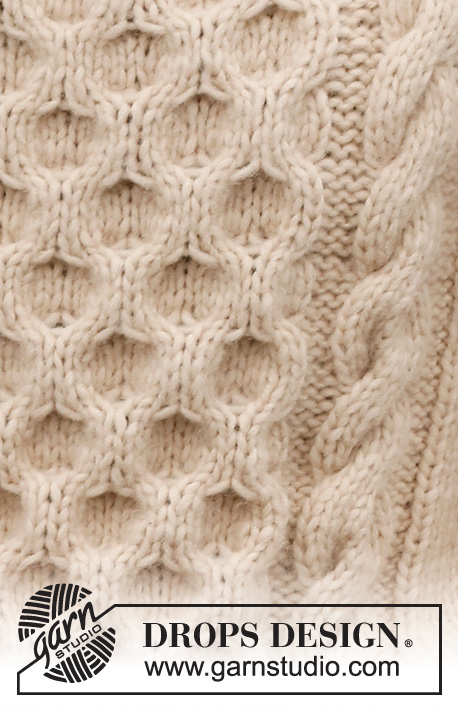



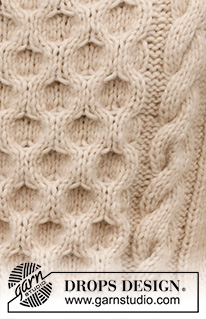


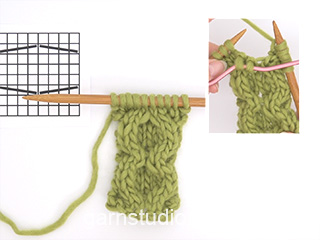













































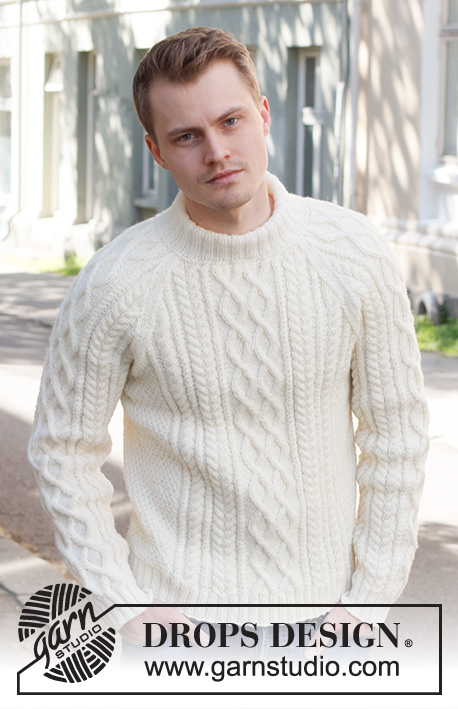








Comments / Questions (9)
Hello, This may be a silly question, how much must the whole garment measure, top to bottom? Are the numbers on the chart in inches or in cm?
27.03.2024 - 11:24DROPS Design answered:
Dear Grace, you can fins all the measurements on the schematic drawings at the bottom of the pattern. The length is on the left side of the drawing. Every measurement is given in centimeters. Happy Knitting!
27.03.2024 - 14:31Ik snap de correctie niet goed. Daar staat hetzelfde als in het originele patroon. Is het patroon nu aangepast en wel degelijk correct?
04.11.2023 - 17:15DROPS Design answered:
Dag Baetens,
Als er een correctie is gemaakt, dan is deze correctie al doorgevoerd in het online patroon. Als je een afdruk hebt gemaakt van voor de correctiedatum dan is de correctie daar nog niet in doorgevoerd.
05.11.2023 - 19:38Hi, thanks for answering my previous question. I’m now stuck on the part on the shoulders where you have to decrease 4 stitches evenly over the cables on A.4/A.6. Do you do the decreases on the one row or over multiple rows? I can’t seem to work it so the cable looks right; instead it looks too small compared to the rest of the piece. Would you recommend any specific way to decrease over the cables? Thanks again!
23.09.2023 - 22:19DROPS Design answered:
Dear Cal, you decrease on one row, in the last row of working the cable. You should be able to decrease normally with knit 2 together. This is all done since, as the cable will contract the piece, we increase stitches for the cables before starting to work the pattern. Then, as we finish the cable, we decrease over the cable stitches so that the neck won't be curved and will be flat. These decreases shouldn't affect the size of the cables. Happy knitting!
25.09.2023 - 00:01I’m stuck when it comes to repeating the pattern; chart A5 is shorter than A4 & A6, where do I start the repeat? Thanks
13.09.2023 - 13:25DROPS Design answered:
Dear Cal, the diagrams are repeated over a different number of rows in height, so when A.5 is done, repeat A.5 from first row and continue A.4 and A.6 as before, when A.4 and A.6 are done in height, repeat them from first row, continuing A.5 as before. Happy knitting!
13.09.2023 - 16:21Winter Hive DROPS Design: Model wi-019 Jeg er ny udi strikkeriets forunderlige verden og indtil videre er det gået rigtigt fint med denne opskrift, hvor alt er godt forklaret. Men jeg kan ikke helt gennemskue, hvordan man strikker ærmekuppel? Synes ikke det fremgår. præcist hvordan man gør dette?
13.01.2023 - 08:21DROPS Design answered:
Hei Thera Du har til nå strikket ermet rundt på rundpinne, men når ermet måler 56-55-54-53-50-49 cm, skal det strikkes frem og tilbake over maskene i noen cm (se hvor mange cm i oppskriften og den str. du strikker). Dette blir da ermtoppen og det blir en splitt iarbeidet fra der du begynte åstrikke frem og tilbake. Ta gjerne en titt på denne videoen, kanskje du da får en bedre oversikt: Hvordan monterer man ærmerne i ryg & forstykke mvh DROPS Design
16.01.2023 - 11:04Bonjour C'est la première fois que j'essaye un patron en forme de texte. Il y a une chose que je ne comprends pas. Pour faire le devant vous demander de monter 74 mailles en taille s. Lorsque j'additionne le nombre de mailles du dessin A1 + A2 + A3 =60 mailles. J'ai une différence de 14 mailles je ne comprends pas où elles sont passées. pouvez-vous m'aider sur le sujet
02.03.2022 - 17:27DROPS Design answered:
Bonjour Mr Lisicki, vous n'allez pas uniquement tricoter les diagrammes, mais en taille S ainsi: 1 m lis, 2 m end, 2 m env, 2 m end, A.1 (= 14 m), A.2 (= 32 m), A.3 (= 14 m), 2 m end, 2 m env, 2 m end, 1 m lis = 1+2+2+2+14+32+14+2+2+2+1=74 mailles. Bon tricot!
02.03.2022 - 17:44Bonjour . Combien de pelotes faut il pour une taille M
12.02.2022 - 19:17DROPS Design answered:
Bonjour Motte, pour la taille M il vous faut 13 pelotes (650 g) de DROPS Wish. Bon tricot!
14.02.2022 - 07:33J\'ai un problème pour payer : aucune de mes carte ne fonctionnent f723333aabf33-12000
31.01.2022 - 17:32DROPS Design answered:
Bonjour Mme Philippart, n'hésitez pas à contacter directement le magasin où vous avez voulu passer votre commande, on pourra vous y aider, même par mail ou téléphone. Bon tricot!
31.01.2022 - 17:58Peut on tricoter le modèle drops 224 15 avec des aiguilles normales?
04.10.2021 - 13:26DROPS Design answered:
Bonjour Iselin, c'est tout a fait possible. Seuls les manches et le col sont tricotes sur les aiguilles double pointes. Bon tricot!
04.10.2021 - 13:54